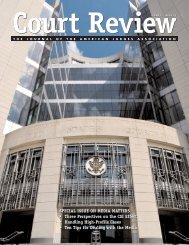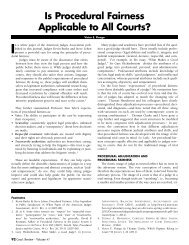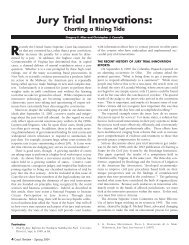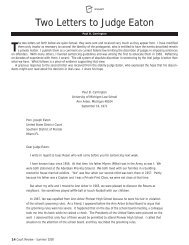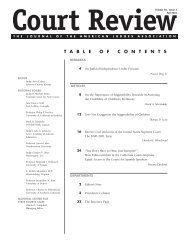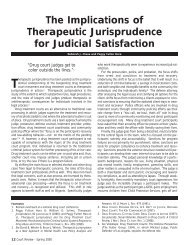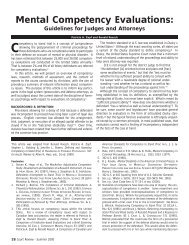The Percepti<strong>on</strong>s ofSelf-Represented Tenants in aCommunity-Based Housing CourtRashida Abuwala & D<strong>on</strong>ald J. FaroleI. INTRODUCTIONThis study examines the impact of Harlem CommunityJustice Center, a community-based housing court thatattempts to achieve speedier and more durable outcomes inlandlord-tenant disputes. However, it may be particularly beneficialto pro se litigants (i.e., those who represent themselveswithout an attorney). In New York City, most landlords arerepresented, while the vast majority of tenants are not. In fact,<strong>on</strong>e report notes that <strong>on</strong>ly 12% of tenants are able to affordcounsel while 98% of landlords are represented. 1The primary objective of this study was to examine theexperiences of pro se tenants whose cases are heard in Harlem,surveying their percepti<strong>on</strong>s of the fairness, accessibility, timeliness,respectfulness, and comprehensibility of the courtprocess. We c<strong>on</strong>ducted a survey of pro se tenants both inHarlem and in New York City’s centralized housing courtlocated in southern Manhattan (hereinafter referred to as“downtown housing court”). Survey results were supplementedwith structured court observati<strong>on</strong>s, also c<strong>on</strong>ducted atboth locati<strong>on</strong>s.BACKGROUNDThe vast majority of housing court cases in New York Cityare filed by landlords to evict tenants for n<strong>on</strong>payment of rent.These tenants are often hampered by their inability to navigatethe complexities of the legal system. Unable to afford legal representati<strong>on</strong>,often unaware of their rights and resp<strong>on</strong>sibilities,and afraid of losing their apartments, many tenants must filetheir own pleadings and resp<strong>on</strong>ses to pleadings in court—anintimidating and complex process. These problems are compoundedby the high-volume of housing court cases such asNew York City’s, which hears more than 300,000 cases annually.2 According to <strong>on</strong>e descripti<strong>on</strong>: “housing court, with itsunruly atmosphere of lawyers and tenants negotiating in thehallways or yelling into cell ph<strong>on</strong>es, can be overwhelming . . .the hearings before some of the most overworked judges in thesystem are usually brief, so litigants often have but a few minutesto recount their emoti<strong>on</strong>al slide into debt.” 3Recently, community-based models have emerged whichoffer alternative approaches to resolving housing cases in NewYork City, as well as the possibility of enhanced access to justicefor pro se litigants. Community courts hearing housingcases were opened in Harlem and Red Hook, Brooklyn.Opened in May 2001, the Harlem Community Justice Centeris located in East Harlem and handles all housing court casesfrom two Harlem zip codes (10035 and 10037). All otherhousing cases in Manhattan are heard at the centralized housingcourt.The Harlem Community Justice Center seeks to addressmany of the underlying problems that give rise to housingcases. The court is staffed by a single judge and handles cases<strong>on</strong>ly from a limited geographic area. It also seeks to providethe judge with access to comprehensive and up-to-date informati<strong>on</strong>.The court works closely with an <strong>on</strong>-site housingresource center that is staffed by case managers, a pro se attorney,and pers<strong>on</strong>nel from partner city agencies. The resourcecenter seeks to link clients to services, including mediati<strong>on</strong>,benefits assistance, budget counseling, and loan assistanceprograms.Aspects of the Harlem Community Justice Center—itsneighborhood locati<strong>on</strong>, smaller caseload, single judge andcourtroom, <strong>on</strong>-site services—might be expected to improve thecourt experience for tenants in terms of both percepti<strong>on</strong>s andoutcomes. The importance of enhanced tenant percepti<strong>on</strong>sshould not be underestimated. Studies show that litigants placegreat weight <strong>on</strong> having their problems settled in a way theyview as fair. 4 To date, there has been no systematic evaluati<strong>on</strong> ofthe impact of a community-based housing court. By drawing <strong>on</strong>the perspectives of unrepresented tenants appearing in both theHarlem and downtown housing courts, our study provides thefirst indicati<strong>on</strong>s of the comparative advantages (and/or disadvantages)of a community-based housing court.Between January and May 2007, a total of 343 tenants wereinterviewed: 196 in the Harlem Housing Court and 147 in thedowntown housing court. The survey measures tenant percepti<strong>on</strong>sabout, and satisfacti<strong>on</strong> with, their court experience.Tenants were asked to assess their experience in a variety ofprocedural fairness domains, including:Footnotes1. COMMUNITY TRAINING AND RESOURCE CENTER AND CITYWIDE TASKFORCE ON HOUSING COURT, INC., HOUSING COURT, EVICTIONS, ANDHOMELESSNESS: THE COSTS AND BENEFITS OF ESTABLISHING A RIGHT TOCOUNSEL (1993), available at http://www.cwtfhc.org/about.html.2. Paula Golowitz, The Housing Court’s Role in Maintaining AffordableHousing, in HOUSING AND COMMUNITY DEVELOPMENT IN NEW YORKCITY 177, 177-202 (Michael Schill, ed., 1999).3. David Chen, Boom Times in the City’s Housing Courts, N.Y. TIMES,May 27, 2003, at B1.4. See, e.g., TOM TYLER, WHY PEOPLE OBEY THE LAW (1990); Tom R.Tyler & E. A. Lind, A Relati<strong>on</strong>al Model of Authority in Groups, in 25ADVANCES IN EXPERIMENTAL SOCIAL PSYCHOLOGY 115 (Mark P. Zannaed., 1992).56 Court Review - Volume 44
• Opportunity to participate in the process;• Clarity of the process;• Polite and fair treatment from the judge and court staff;• <strong>Fairness</strong> of the outcome; and• Satisfacti<strong>on</strong> with the outcome.Tenants were also asked to rate their preparati<strong>on</strong> for court,difficulties faced in preparing for the appearance, awarenessand use of available services, and suggesti<strong>on</strong>s for improvement.5To complement the survey, research staff c<strong>on</strong>ducted structuredcourt observati<strong>on</strong>s in the Harlem and downtown housingcourts. Using court observati<strong>on</strong> instruments, we formallyassessed tenant court appearances in terms of preparati<strong>on</strong>,behavior during the appearance, treatment by other parties(judge, court clerks, attorneys, etc.), and case outcomes. Intotal, 406 court appearances were observed: 109 in the Harlemhousing court, and 297 in various downtown court parts.II. DESCRIPTION OF SURVEY SAMPLEOverall, survey resp<strong>on</strong>dents appear to be generally representativeof housing court tenants. Most of those interviewedwere racial/ethnic minorities—half African-<strong>American</strong> andanother quarter Hispanic. Two in three (67%) were female. Themajority had at least <strong>on</strong>e indicator of low socioec<strong>on</strong>omic status:59% reported being unemployed, receiving Secti<strong>on</strong> 8rental assistance, or living in public housing (Table 1).Those interviewed in the Harlem and at the downtownhousing courts were similar in many, but not all, respects.There were no significant differences across sites in gender,educati<strong>on</strong> level, and employment status. However, those interviewedin Harlem were more likely to identify themselves asAfrican-<strong>American</strong> (63% compared to 36% downtown) and lesslikely as white (4% compared to 16 % downtown).CASE CHARACTERISTICSNot surprisingly, more than eight in 10 (85%) of those surveyedwere involved in a n<strong>on</strong>payment of rent case. A largerpercentage of downtown litigants were in court <strong>on</strong> a holdovercase (19% vs. 7% downtown). 6 Also not surprisingly, the overwhelmingmajority of tenants, both downtown (87%) andparticularly in Harlem (97%), appeared pro se. By c<strong>on</strong>trast,very few tenants reported that their landlord was pro se (5% inHarlem; 6% downtown). The majority of tenants (53%) alsoreported that they are facing evicti<strong>on</strong> as a result of their currentcourt case. Importantly, despite the fact that public housing(NYCHA) cases comprise a larger percentage of Harlem’sthan downtown’s caseload, the Harlem tenants interviewed forthis study were not significantly more likely to be publichousing residents than were those downtown (29% vs. 25%,respectively).TABLE 2: CASE CHARACTERISTICSHARLEM DOWN- TOTALTOWNTABLE 1: CHARACTERISTICS OF SURVEY RESPONDENTSCASE TYPEHARLEM DOWN- TOTALN<strong>on</strong>payment***92% 76% 85%TOWNHoldover***7% 19% 13%RACEOther***2% 4% 3%Black***Latino †63%21%36%31%51%25%TENENT IN PUBLIC HOUSING(NY CHA) 29% 25% 28%White4% 16% 9%Other12% 18% 15%FIRST APPEARANCE INCOURT CASE † 26% 19% 23%GENDERFemale** 70% 63% 67%TENANT PRO SE* 97% 87% 93%HIGH SCHOOL DIPLOMA/GED 86% 86% 86%LANDLORD PRO SE 5% 6% 5%EMPLOYED***68% 59% 64%TENANT FACING EVICTION* 45% 62% 53%Part-time11% 17% 14%Full-time57% 42% 50%*p



